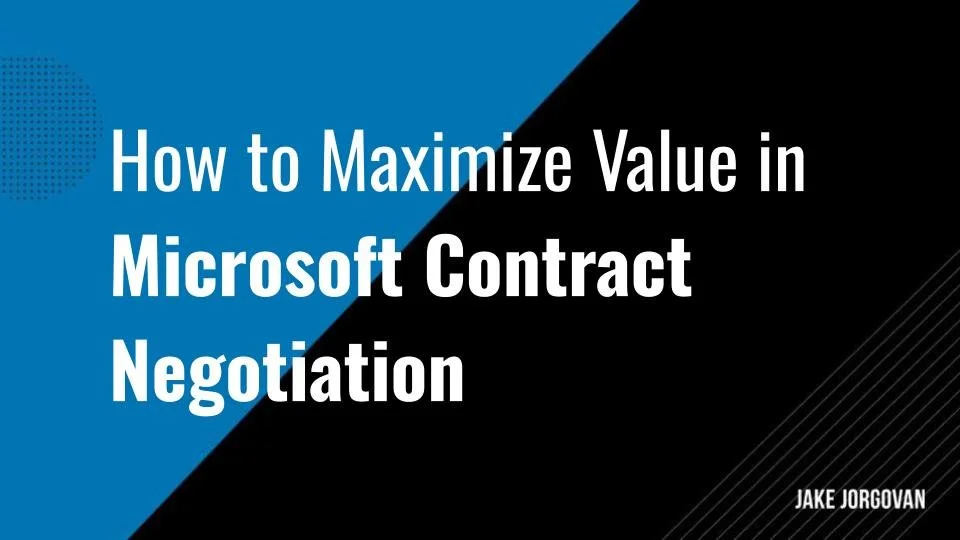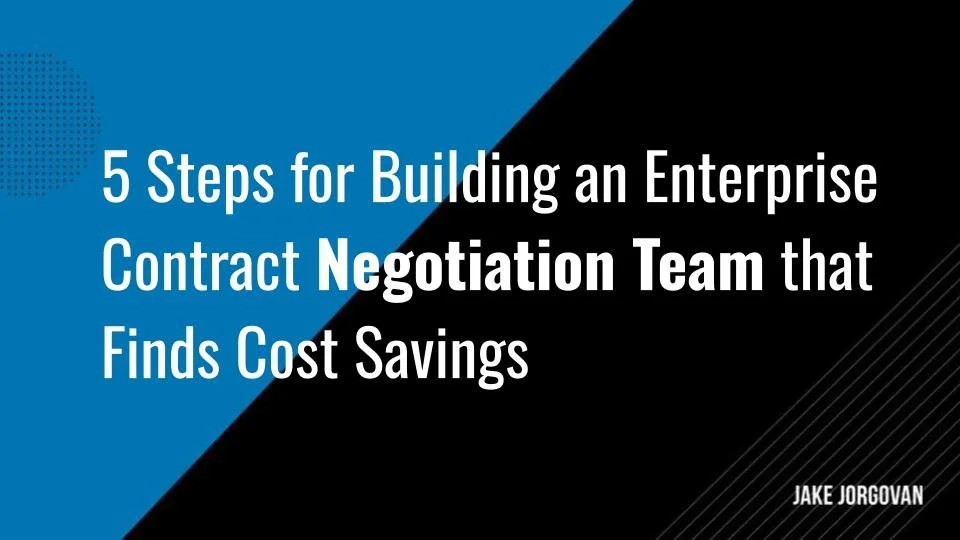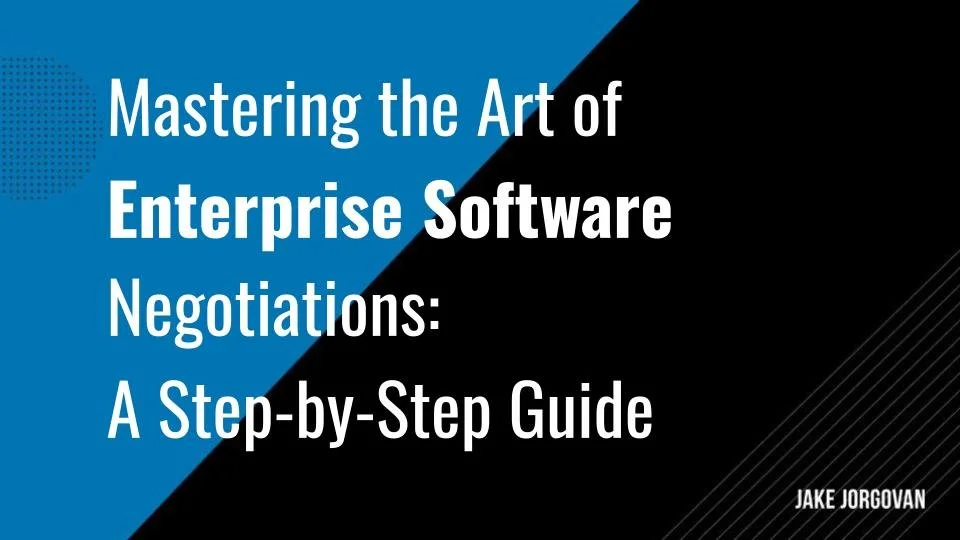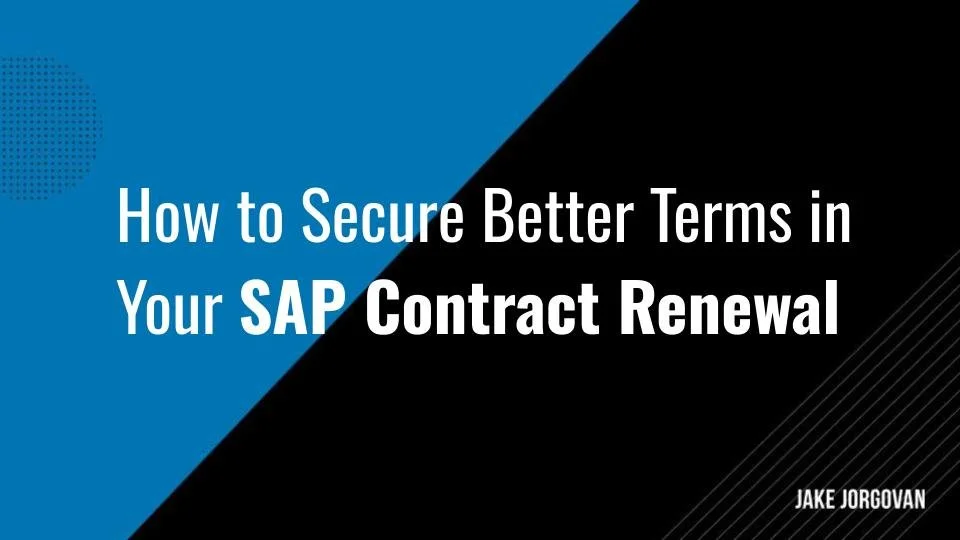How to Identify and Avoid Hidden Fees When Negotiating Enterprise Software Contracts for Cost Savings
Hidden fees in enterprise software contracts can devastate your budget. In fact, ineffective contract management can lead to revenue losses of up to 9.2% annually.
Identifying and avoiding these fees is crucial for cost savings.
This guide will empower you to negotiate better deals. We'll explore common hidden fees (both direct costs and indirect costs) and provide strategies to sidestep them.
Use this knowledge to ensure your software investments are cost-effective, identify opportunities for cost savings, and make smarter strategic decisions.
Let’s dive in.
Understanding Hidden Fees in Enterprise Software Contracts
Hidden fees in enterprise software contracts are a common tactic used by software providers to increase their revenue. These fees can be embedded in various contract sections, making them difficult to identify without a thorough review. Poor contract management can exacerbate potential issues, leading to unnecessary administrative costs and financial surprises.
As a business owner, understanding and identifying these fees is crucial to avoid unexpected costs that significantly impact your budget. Here are some of the ways to identify hidden fees:
Hidden fees often appear in the form of additional charges for support, maintenance, upgrades, or usage beyond certain limits. These extra charges are usually not highlighted upfront and can emerge later in the contract term. Some contracts include vague terms like “additional services” or “extra usage fees,” which are open to interpretation and can lead to substantial additional costs.
Check all contract terms carefully for effective contract management. Look for any ambiguous language that could be interpreted in ways that allow the vendor to impose extra fees. For example, terms related to user licenses, data storage, and service levels should be clearly defined and understood. Failure to do so can result in unexpected operational costs that are difficult to contest once the contract is signed.
Other terms include “reasonable,” “material,” or “substantial.”
Customer shall reimburse Service Provider's reasonable out-of-pocket expenses incurred in connection with the Services.
It is also important to request a detailed breakdown of all potential fees before signing the contract. This includes understanding the conditions under which these fees apply and negotiating caps on variable costs. Clear terms for fee adjustments and renewals should be included to protect your interests throughout the duration of the contract, helping to mitigate administrative costs and ensure that the relationship with the service provider remains balanced and beneficial.
5 Steps for Avoiding Hidden Fees in Enterprise Software Contracts
Now that you’ve seen the dangers of hidden fees, here’s how to avoid them:
1) Conduct Thorough Research on Standard Industry Fees
Understanding the standard fees in enterprise software contracts saves significant short- and long-term costs. It requires strategic inquiry and comparison.
To identify these fees, you need to follow a detailed process. First, research what other companies in your sector are paying for similar software platforms. Use industry reports, forums, and case studies to gather data.
Engage with consultants or industry analysts who specialize in enterprise software. Their insights can reveal common hidden fees and negotiation tactics.
Then, review your past software contracts to identify any unexpected fees that appeared later. This historical data is crucial for recognizing patterns and preparing for negotiations. This is where good contract management comes into play — 71% of companies cannot locate 10% or more of their contracts, which shows the importance of thorough contract management to avoid unforeseen costs.
In the image below, you can see a screenshot from the contract management tool Folderit:
At this stage, it may help to join industry groups or professional networks where peers discuss their experiences with various vendors. First-hand accounts often highlight hidden costs not mentioned in standard contract reviews.
Throughout the process, use specialized tools and platforms that compare vendor pricing and contracts. These tools can provide a clear picture of standard fees and highlight discrepancies.
2) Review the Contract for Vague or Ambiguous Terms
Navigating enterprise software contracts requires a keen eye for detail. Often, hidden costs lurk in ambiguous terms and lead to unforeseen expenses.
Here’s an example of what a typical software licensing contract might look like:
Dissecting these contracts methodically allows you to avoid costly surprises and secure more favorable terms. Here’s how to get started:
Scrutinize definitions: Review all defined terms carefully. Ambiguities in definitions can lead to additional charges. Ensure that terms like “user,” “seat,” and “usage” are explicitly defined.
Examine renewal clauses: Check for auto-renewal terms that might lock you into higher rates. Look for clear conditions under which rates can increase and make sure they are reasonable. Inflation typically increases by several percentage points each year, so vendors tend to introduce cost increases to protect themselves.
Identify hidden service fees: Look for any vague language around support, maintenance, or upgrade fees. Ensure these are clearly outlined and capped where possible.
Check for out-of-scope costs: Identify terms that could result in out-of-scope charges. Be wary of phrases like “additional fees may apply” without specific conditions and costs.
Clarify customization clauses: Ensure any terms regarding customization or bespoke development are detailed. Ambiguity here can lead to significant unexpected expenses.
Insider tip: We always recommend negotiating a clause that requires the vendor to provide a comprehensive fee schedule up front. This preemptive step often discourages the inclusion of vague terms and helps ensure cost transparency from the beginning.
3) Negotiate a Cap on Annual Fee Increases
Negotiating enterprise software contracts can lead to unexpected cost increases if annual fees are not capped. Many vendors impose yearly hikes, sometimes without clear limits. Controlling these increases is essential to managing your budget and avoiding financial strain.
Start by explaining the maximum percentage that fees can increase annually. This cap should be reasonable and based on industry standards. For instance, the ERP software SAP announced that it would increase on-premise annual support fees by an average of 5% starting January 2024, citing local Consumer Price Index (CPI) rates.
Tie fee increases to a specific index like the Consumer Price Index (CPI). This provides a transparent and predictable way to manage cost adjustments.
Remember to require vendor approval for any increases beyond the agreed cap. This ensures you have a say in any significant price changes. Lock in rates for a set period, such as two to three years. This stability helps with long-term budget planning.
Finally, analyze the vendor’s past fee increases. Use this data to negotiate a cap that reflects their historical behavior, avoiding unexpected bills.
4) Ask for a Detailed Breakdown of all Potential Fees
Hidden fees in enterprise software contracts can inflate costs unexpectedly. A detailed breakdown of all potential fees is crucial to avoiding these surprises. The image below shows some common hidden costs with software.
To ensure transparency and control, follow these steps:
Request comprehensive fee disclosure: Ask the vendor to list all possible fees and monthly costs upfront. This should include licensing, support, maintenance, and any other recurring or one-time charges.
Categorize fees: Break down the fees into categories such as setup, subscription, additional user licenses, training, and customization. This helps you understand the full spectrum of potential costs.
Clarify fee triggers: Ensure each fee category specifies what actions or events trigger the fee. For example, adding new users or exceeding data limits can incur additional costs.
Demand caps on variable fees: For fees that vary based on usage or other factors, negotiate caps to limit the maximum amount you could be charged.
Include a fee review clause: Add a clause that allows for periodic reviews of the pricing structure. This ensures that any discrepancies or unjustified fees can be addressed and adjusted.
Insider tip: We advise including a right-to-audit clause in your contract. This allows you to periodically audit the vendor’s billing practices and ensure that all fees charged align with the agreed terms. This proactive measure helps maintain cost transparency and control.
“Including a right to audit clause in your contract obligates your vendors to disclose data and to report with your organization on request.” — Venminder
5) Include Clear Terms for Fee Adjustments and Renewals
Enterprise software contracts often include clauses leading to repeated costs over time. Ensuring these terms are clear and well-defined helps control expenses and prevent surprises.
To effectively manage fee adjustments and renewals, follow these steps.
First, clearly outline the terms for contract renewal. Make sure it states whether the contract auto-renews and under what conditions you can opt out.
Next, detail the process for adjusting fees. This should include how and when fee changes can be proposed and implemented. Set a reasonable notice period for fee adjustments. This gives you ample time to review and negotiate any proposed changes. For instance, a 90-day notice period before contract renewal is common, providing ample time to assess and respond to fee adjustments.
You’ll also want to add clauses that mandate periodic reviews of the contract terms, particularly fees, as this allows you to reassess and renegotiate terms as needed. And always be sure to clearly define the conditions under which you can terminate the contract without penalty. This is crucial if fee increases become unsustainable.
The graphic below shows some of the key things to keep in mind when renewing your contract.
Common Mistakes When Negotiating Enterprise Software Contracts for Cost Savings
Saving costs with your enterprise software contracts isn’t always easy. Let’s take a look at some of the most common mistakes businesses tend to encounter here, based on real-world scenarios:
1) Failing to Pinpoint Conditional Fees Early On
Many vendors embed conditional fees that only activate under specific circumstances, such as exceeding storage limits or adding a certain number of users. Buyers often focus on base pricing while ignoring these “if-then” charges.
Expert Tip: During negotiations, ask for a comprehensive list of triggers for conditional fees. A common pitfall is not addressing data overages—vendors sometimes charge exorbitant rates for additional gigabytes used. For instance, one enterprise reported a 400% increase in annual costs because their contract didn’t cap storage expansion fees.
2) Assuming Industry Standards Are Fair
Companies often accept industry-standard clauses like annual fee escalations without questioning them. However, “standard” doesn’t always mean “fair.” Vendors may inflate percentages under the guise of industry norms.
Expert Tip: Instead of accepting vendor claims at face value, benchmark escalation clauses against specific examples. For instance, SAP’s 5% increase for support fees might seem standard, but many competitors offer flexibility based on customer loyalty or long-term commitments. Leverage this during discussions to negotiate lower caps.
3) Overlooking Bundled Services
Bundling is a classic upsell tactic. Vendors pitch bundled packages that include features you may not need but end up paying for. Businesses often sign contracts thinking the additional services are “free” or “value-added,” only to discover hidden fees during renewal.
Expert Tip: Break down bundles into individual line items and evaluate the true value of each service. For instance, if advanced analytics is bundled, clarify whether it’s an add-on at a discount or part of the base price. Negotiate to exclude unnecessary features and reduce overall costs.
4) Ignoring the Vendor’s Compliance Responsibility
Contracts often shift compliance risks to the buyer, especially for data privacy regulations like GDPR or CCPA. Companies sometimes overlook vague clauses stating that compliance fees are the customer’s responsibility, leading to unexpected charges after audits.
Expert Tip: Negotiate a clause that ensures the vendor shoulders compliance-related costs tied to their platform or services. For example, one IT manager discovered that their vendor charged extra for enabling encryption features, despite marketing them as standard.
5) Not Analyzing Fee Adjustments During Renewals
Renewal negotiations are often rushed, with buyers focusing on retaining service continuity instead of dissecting fee adjustments. Vendors take advantage by adding terms that increase costs subtly, like automatic license tier upgrades.
Expert Tip: Review all fee adjustments applied during previous renewals. If you notice a pattern of steep increases, push back with historical data to establish predictable pricing for future terms. For instance, one SaaS customer reduced their renewal costs by 20% by providing evidence of declining service usage.
6) Skipping Vendor Financial Health Checks
Enterprises often skip due diligence on a vendor’s financial stability. A vendor’s financial troubles can lead to unexpected additional charges, such as fees for expedited support or unplanned service changes.
Expert Tip: Request transparency on the vendor’s financial health and investment in the product. Signs of downsizing or increased reliance on premium service fees can indicate instability. In one instance, a vendor abruptly increased support costs after losing key accounts, which blindsided unprepared customers.
7) Underestimating the Cost of Exiting the Contract
Exit clauses often include fees for migrating data, canceling early, or transferring licenses. These costs can skyrocket if they aren’t addressed during initial negotiations.
Expert Tip: Clarify exit costs before signing. For instance, in one enterprise’s case, the vendor charged $50,000 to provide a full data export at the contract’s end—something that could have been capped or waived during the initial negotiation phase.
Frequently Asked Questions
What are hidden charges in a contract?
Hidden charges are undisclosed or vaguely defined costs within a contract that often arise from ambiguous terms, additional usage, or required services that aren’t explicitly outlined.
What are the consequences of hidden fees in software contracts?
Hidden fees can lead to unexpected financial strain, budget overruns, and strained vendor relationships due to a lack of transparency.
What are common hidden software fees?
Common hidden software fees include additional user licenses, data overage charges, support or maintenance costs, customization fees, and fees for exceeding contract terms.
How do you avoid hidden software fees?
You can avoid hidden fees by requesting a comprehensive fee breakdown upfront, negotiating caps on variable fees, and including right-to-audit and fee review clauses in the contract.
Why is software so expensive?
Software is expensive due to development costs, ongoing maintenance, support services, and the inclusion of licensing or subscription fees that often scale with usage.
































